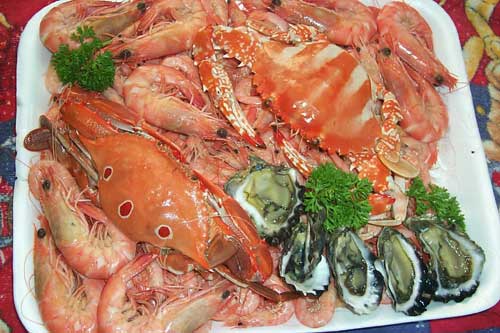Indicators of shellfish quality?
Bivalve molluscs (shellfish) are filter-feeders meaning they feed by filtering water through their gills. Because of their effective filtration mechanism, shellfish may accumulate microbiological, chemical and biological contaminants from the water. Bioaccumulation of contaminants by shellfish is a human health issue and is indicative of declining water quality and ecosystem integrity.
Some suggested indicators of shellfish quality for State of the Environment reporting of Estuaries and the Sea are1:
- changes in the number of seafood samples that exceed Maximum Recommended Limits (MRLs);
- the type, severity and frequency of food poisonings related to seafood consumption;
- the effort expended in national monitoring of seafood quality; and
- the extent of post-harvest treatment facilities required to manage the problem.
Some other shellfish-related indicators are:
- Contaminant levels and changes in contaminant levels in the tissues of shellfish such as oysters and mussels (i.e. Indicator 6.2 in the State of the Environment report for Estuaries and the Sea)1. The measurement of contaminant levels (e.g. toxicants and pathogens) in biological tissues complements measurements of concentrations found in sediment, and is a good way to monitor long-term trends in sediment and water quality1. Moreover, water samples only yield information on the water for the time of sampling.
- The number of weeks per year in which coastal waterways were closed to shellfish harvesting was adopted as an indicator of ecosystem integrity during the National Land and Water Resources Audit. The status of closed is applied to an area by a state agency where the harvesting of shellfish is temporarily prohibited due to contamination.

Photo 1. A selection of seafood.
Significance
Shellfish beds require stricter land use and pollution control measures than many other environments because contaminated shellfish constitute a serious threat to human health and to ecosystem integrity. Consumption of contaminated seafood can cause a broad range of toxicological effects in organisms, or even their death. The ingestion of algal biotoxins through shellfish consumption results in a dramatic suite of symptoms and syndromes in humans (e.g. paralytic, neurotoxic, amnesic and diarrhetic shellfish poisonings). In the ecosystem, chemical pollutants may accumulate and magnify up through the food chain in a process called biomagnification. This lowers the reproductive abilities of organisms at higher trophic levels and renders them more susceptible to infectious disease. Economic impacts are many and varied but include costs of medical care and of closure of harvesting areas (see more detailed discussions under the economic consequences of algal blooms and commercial fisheries). The latter have implications for producers, processors and retailers.
Human activity and uses that give rise to shellfish contamination
- Bacterial contaminants including faecal coliforms and viruses are derived from stormwater and other coastal discharges. Risks to humans from pathogenic organisms are presumably higher in areas with large population densities or with a significant tourism.
- Chemical pollutants including metals, chlorinated organic compounds and pesticides are often found in runoff from agricultural areas and in discharges from urban and industrial point sources. The iIndustrial point source hazard and wastewater discharges indicators can be used to assess chemical pollutant risk from urban and industrial sources. The pestcide hazard indicator can be used to assess chemical pollutant risk from agricultural sources.
- Shellfish may also accumulate biotoxins by feeding on harmful algae. Increased frequency and severity of harmful algal blooms is often symptomatic of excessive loads of nutrients (leading to eutrophication). Some point-sources of nutrients to coastal waterways are wastes from aquaculture operations, sewage discharged from yachts, boats & ships and coastal discharges such as outfalls from industry. The risk imposed by point-sources of nutrients in coastal waterways is higher in areas with large population densities or with a significant tourism, and can be estimated by the number of point-sources per unit area of coastline. Nutrients loads from diffuse sources (e.g. intensive agricultural in catchments and urban stormwater) are often larger and more difficult to control.
Considerations for measurement and interpretation
See ‘monitoring and design strategies’ and ‘analysis and interpretation’ under Indicators 4.4 and 6.2 in the State of the Environment report for estuaries and the sea1.
Existing information and data
Shellfish quality assurance programs exist in all states, and growers are encouraged to report events such as algal blooms, fish kills, water discolouration (including turbidity), incidences of increased bird numbers and heavy rainfall to local authorities. Emergency closures of shellfish waters are often made on the basis of significant environmental events such as rainfall, faecal coliform counts or the occurrence of algal blooms. Depuration confers additional quality assurance in areas subjected to intermittent contamination, but is ineffectual in heavily polluted waters.
Government institutions and state agencies responsible for managing coastal ecosystems keep records of shellfish closures and have data on contaminants in relevant taxa. Commonwealth health and fishing authorities have some data on seafood quality although not all of it is publicly available.
For more information consult the Australian Shellfish Sanitation Control Program; Operations Manual Ist Edition 10/4/97. The Canadian Shellfish Quality Resource website has some general marine biotoxin links.
Default water quality targets for turbidity and nutrient levels to protect human consumption of aquatic foods and aquaculture values for different bioregions are provided in Water Quality Targets Online.
Contributors
Kerrod Beattie, Queensland Department of Primary Industries.
- Ward, T., Butler, E. and Hill, B. 1998. Environmental Indicators for National State of the Environment Reporting, Estuaries and the Sea, Commonwealth of Australia, pp. 81. ↩ ↩ ↩ ↩


